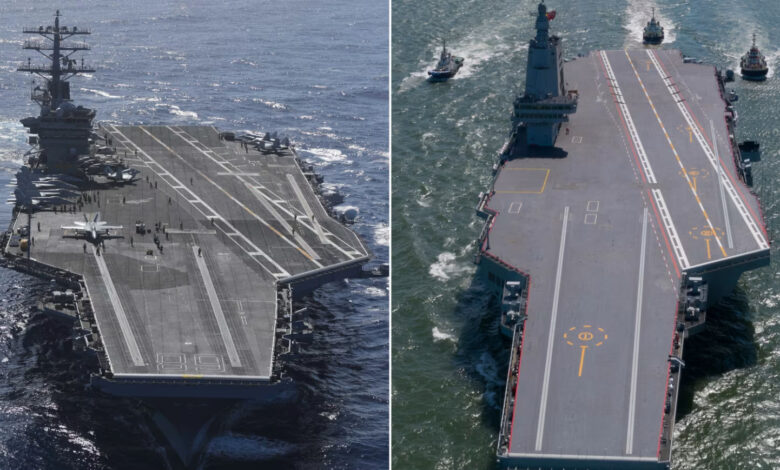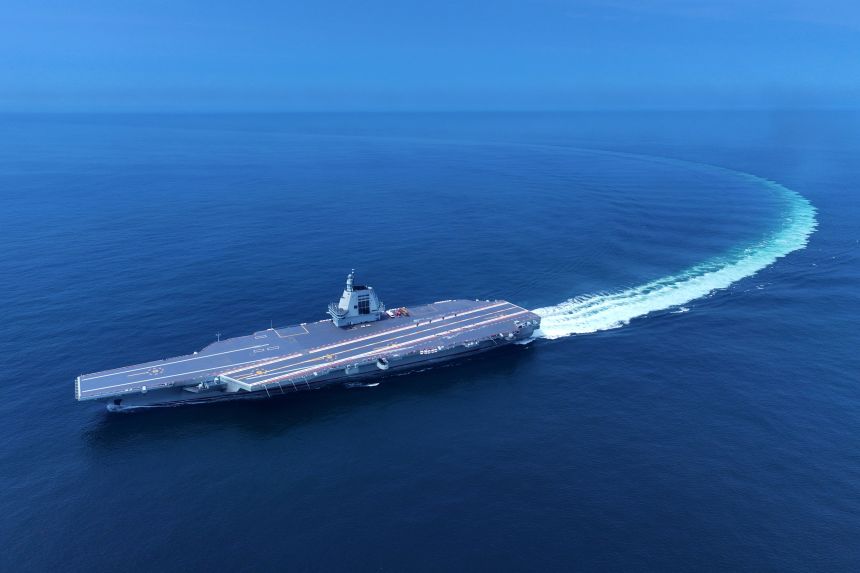
China’s newest aircraft carrier may only be able to conduct air operations at about 60 percent the rate of a 50-year-old US Navy carrier, two former US carrier officers say, a substantial combat limitation for a vessel meant to revolutionize Beijing’s fleet.
The officers told CNN the configuration of the flight deck of the Fujian, expected to be commissioned soon, limits the pace at which aircraft can be launched and recovered, especially when compared with the Nimitz-class US carriers.
“The Fujian’s operational capability is only about 60 percent of that of the Nimitz class,” said Carl Schuster, a former US Navy captain who served on two US aircraft carriers.
After examining the photographs of the Fujian’s flight deck, Schuster and retired Lt. Cmdr. Keith Stewart, a former US naval aviator, noted that the Fujian’s deck layout limits simultaneous takeoffs and landings.
In a major step forward, China has built the Fujian with an electromagnetic catapult aircraft launching system – which allows aircraft to take off with heavier weapon and fuel loads so they can strike enemy targets from greater distances. Only the US fleet’s newest and biggest carrier, the USS Gerald R. Ford, can match it.
That flight deck configuration is a first for a Chinese carrier. Its first two carriers – the Liaoning and the Shandong – use a ski jump-style ramp to get aircraft airborne under their own power.
Configuring a new type of carrier from scratch may have led to the limitations.
The issue of the Fujian’s ability to conduct air operations was first raised after a Chinese military blogger watched a video about the Chinese military on state-run CCTV, which featured a segment on the Fujian.

After watching the documentary, the blogger, writing on the military commentary blog Haishixianfeng, said: “Both of the catapults are situated close to the middle-front section of the landing area, so either the J-15 or J-35 (China’s two carrier-based fighter jets) would roll over the catapults when they land, temporarily preventing them from being used for launch operations and thus affecting the takeoff efficiency of the fighter jets.”
The comments were picked up by South Korea’s Chosun Ilbo newspaper, and CNN asked the two former US Navy officers to review that report and the video.
Schuster said the angle at which the landing area crosses the Fujian’s deck is only 6 degrees off center, compared with 9 degrees on the US carriers, limiting space between the landing strip and the forward two catapults.
Additionally, the Fujian’s landing area is longer than that of the Nimitz, meaning it extends too close to the bow area where aircraft are positioned for catapult-assisted launching, he said.
The “longer landing area and the narrower deck angle reduces the space for repositioning the recovered aircraft,” Schuster said.
The US officers also noted that the forward catapults seem to be longer on the Fujian than the Nimitz.
Essentially, aircraft would be at risk of flight deck collisions as they move to and from elevators to the hangar deck below for takeoffs and landings, Schuster and Stewart said.
The only option is to reduce the pace of flight deck operations to try to prevent flight deck mishaps, they said.
China has been building the world’s largest navy, launching high-tech warships at a frenetic pace under the leadership of Xi Jinping, putting pressure on the United States and its Pacific allies to keep pace.

But when it comes to aircraft carriers, the US has a large lead, at least in numbers, with 11 active carriers to China’s two, with the Fujian’s activation expected in the coming weeks.
The Liaoning and the Shandong are smaller – displacing 60,000 to 70,000 tons – and their launch system limits the weapons and fuel load of aircraft.
Displacing 80,000 tons, the Fujian is the closest thing afloat to the US Navy’s 97,000-ton Nimitz-class carriers, which make up 10 of the 11 carriers in the US fleet.
The USS Nimitz, commissioned in May 1975, is the oldest carrier in the US fleet. Earlier this month, it entered the South China Sea via the Singapore Strait, according to the USNI News, on what is expected to be its last deployment before decommissioning next year.
Meanwhile, satellite imagery from late September showed Fujian docked at Hainan island in the northern part of the South China Sea, where its commissioning ceremony is expected soon.
The carrier movements come as US President Donald Trump heads to the region, with stops in Malaysia, Japan and South Korea in the next few days.
The Fujian has gotten high praise in Chinese state media, with Chinese military affairs expert Zhang Junshe last month telling Global Times that successful launch trials in it show “China is becoming a major aircraft carrier power, with both the carrier and its aircraft achieving world-class in key metrics.”
“This not only showed that the PLA has fully mastered and matured the application of complex electromagnetic catapults, but also reflected the continuous improvement in the capability and proficiency of naval personnel in operating high-tech equipment,” Zhang is quoted as saying.
Schuster said the Fujian is more likely a stepping stone, and China’s next carrier, the Type 004, on which early construction is believed to have begun, will incorporate lessons learned from it.
Meanwhile, Stewart said the carrier ops are one place China has a lot to learn, especially since Fujian is its first carrier with a catapult system.
“There is an old Navy proverb which states ‘all carrier operational rules and regulations are written in blood,’ which means somebody was either seriously injured or killed during flight ops,” Stewart said.
“I’ve seen several folks killed on flight decks and know just how dangerous an arena it can be.
“Building a shiny new carrier is nice, but I would postulate that the Chinese ‘don’t know what they don’t know’ about carrier ops,” he said.
That can only be learned by practice in all kinds of conditions, according to Stewart.
“Flying off a carrier in daylight and good weather is not too difficult. The hard part, and what makes flyers pucker their cheeks, is flying and landing on a nasty, rainy, windy night when the deck is wallowing up to 18 feet, you are low on fuel, and you are scared.
“If anybody tells you that they’ve never been scared during night ops, they are delusional,” Stewart said.




